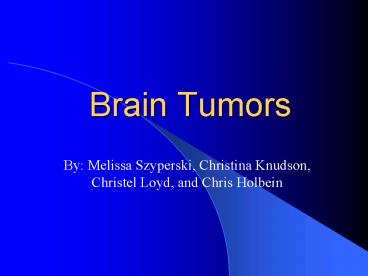Brain Tumors - PowerPoint PPT Presentation
1 / 16
Title:
Brain Tumors
Description:
Malignant gliomas are the leading cause of death in children ... CAT Scans. MRI. Surgical biopsy. Treatments. Open Surgery. Stereotactic Surgery. Chemotherapy ... – PowerPoint PPT presentation
Number of Views:5275
Avg rating:3.0/5.0
Title: Brain Tumors
1
Brain Tumors
- By Melissa Szyperski, Christina Knudson,
Christel Loyd, and Chris Holbein
2
General Information
- Malignant gliomas are the leading cause of death
in children and adults. - Approximately 17,000 will be diagnosed with a
primary brain tumor each year - Prognosis is dismal
- Most patients die within the first year
3
Types of Brain Tumors
- Primary tumors start in the brain
- -Benign
- -Malignant
- Metastatic tumors begin in another part of the
body and spread to the brain
4
Benign Tumors
- Benign tumors do not spread into the nearby body
tissue - These tumors are non-cancerous
- People rarely die from benign tumors
5
Malignant Tumors
- Malignant tumors in the brain invade nearby
tissue - Cancerous
- They are life threatening
- Gliomas are the most common type of brain tumor
6
Malignant Gliomas
- Tumors are caused by abnormal cell growth
- Tumors are categorized using the World Health
Organization classification scale - Four grades measured by the level of severity
- Glioblastoma multiforme is a grade 4 tumor
- Not sure as to exact cause
7
Symptoms
- Headache
- Seizures
- Convulsions
- Speech problems
- Impaired vision
- Weakness in parts of the body
- Problems with understanding
8
Diagnosis
- Check family history
- NF1 and/or NF2 gene mutation
- Physical examination
- Radiological tests
- CAT Scans
- MRI
- Surgical biopsy
9
Treatments
- Open Surgery
- Stereotactic Surgery
- Chemotherapy
- Chemo wafers in the brain
- Radiation
10
Active Areas of Research
- Poor outcome for these patients
- Possible reason is that at a molecular level we
do not completely understand the processes that
occur in the transformation of a normal cell into
a cancer cell.
11
Gene Expression
- Transcription
- DNA RNA
- Translation
- mRNA Protein
- Gene expression is being used to better
understand the process cells go through to become
cancerous
12
Protocols
- Establish primary cell cultures for each
patients tumor. - Extract total RNA
- Microarray
- Examines 1000s genes simultaneously
- Immunohistochemistry
- Confirm the type of cells being evaluated
13
Data
- Examine quality of total RNA Sample
- Determine the concentration of RNA
14
Immunohistochemistry
- Use pictures to look at the cells, stained with
dye, even more thoroughly
15
Acknowledgments
- We would like to thank Zita Sibenaller for
allowing us to shadow her all week and use her
lab. - We would also like to thank Jose for planning
this course and giving us guidance during this
great opportunity. - Finally we would like to thank our TAs and RAs
for taking us to our daily activities and helping
us when we needed it.
16
References
- Berger, M. Wilson, C. (1999). The Gliomas.
Philadelphia W.B. Saunders Company. - National Cancer Institute. 3/31/2003. What You
Need To Know About Brain Tumors. 6/19/2003
lthttp//www.nci.nih.gov/cancerinfo/wyntk/braingt. - Shapiro, W. R. (April 1999). Current Therapy
for Brain Tumors. Neurological Review, Vol. 56,
P. 429-432. - Z. Sibenaller. Personal Interview. June 23-26,
2003.































